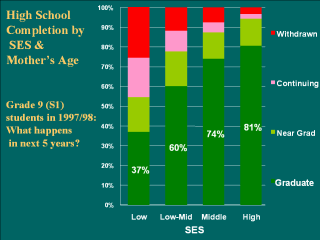| front |1 |2 |3 |4 |5 |6 |7 |8 |9 |10 |11 |12 |13 |14 |15 |16 |17 |18 |19 |20 |review |
 |
How do these results focusing on performance on
a Grade 12 standards test reflect what proportion of children from each
socioeconomic group will eventually graduate from high school? Grade 9
students in the 1997-98 school year were tracked for the following five
years. Results showed that only 37% of students from the low-SES
neighbourhoods graduated within six years of entering Grade 9. An additional
17 % of students from low-SES neighbourhoods were “near graduation” meaning
that they had made it to grade 12 but had not yet graduated after six years.
One in four students had withdrawn even before completing high school. An
additional 20% were still in school six years after Grade 9 but had not yet
made it to Grade 12 (shown as “continuing” in the graph). The picture
differed considerably for students living in other neighbourhoods. In the
high-SES areas, 81% had completed high school within five years and only 3 %
had withdrawn.
While it is clear that the rate of poor educational outcomes is much higher in the children who live in the lower SES neighbourhoods, because so much of the population lives in the middle class neighbourhoods, the actual number of children not graduating from high school is highest there. |